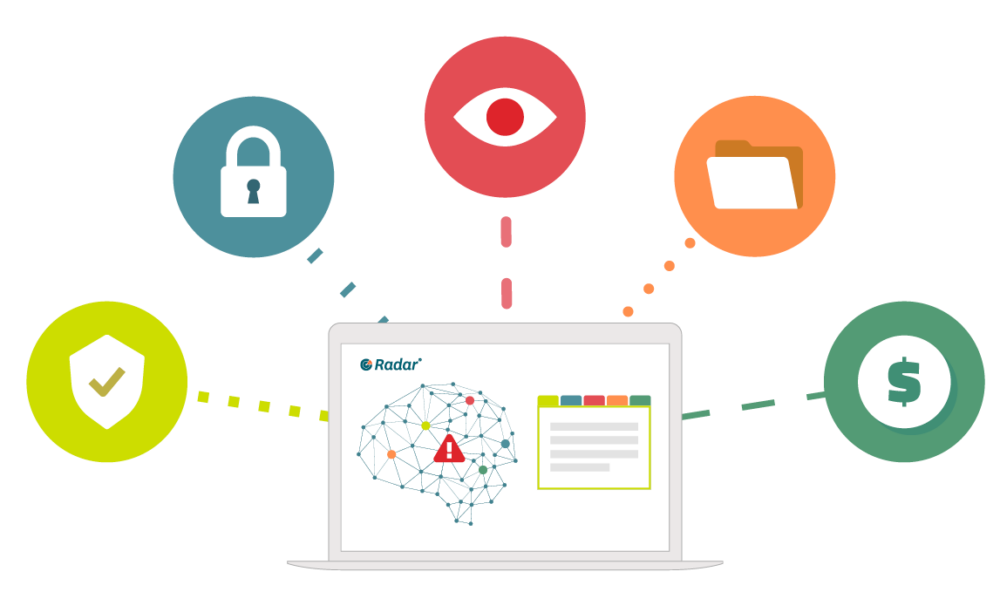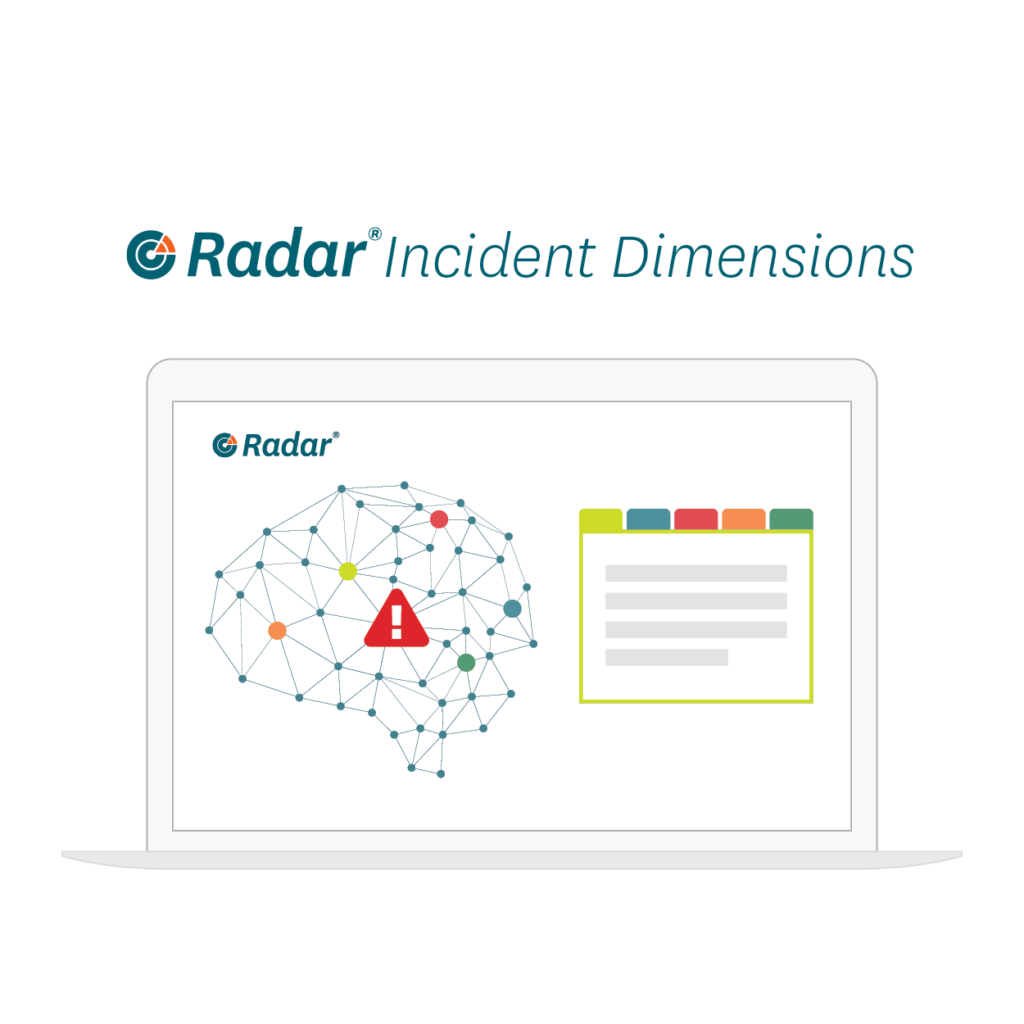
Incident Dimensions in Radar®
Unify privacy incident management across your organization
Incidents Don’t Exist in a Vacuum
The challenges that incident management teams face multiply when they struggle to work in concert with other impacted teams who have a critical role to play in the resolution of an incident.
As a result, the incident response process has grown exponentially more complex and teams must quickly gather the facts while it races against tight timelines to comply with a multitude of regulations.

Unify Incident Management
The Incident Dimensions capability in the Radar® platform allows incident response teams to consolidate the incident management process in a single tool. In doing so, these teams can successfully manage the collaboration with each functional area that is directly connected to any one incident.
Incident Dimensions is the rallying point for multiple teams working on an incident. A unique workflow augments the incident management process and allows each team the flexibility to view and manage their own obligations.
Team members from a variety of departments can easily interact with their aspect of an incident that is directly relevant to their discipline and responsibilities.
Many organizations require their employees to “see something, say something.” Therefore, an incident can start anywhere. Not an issue with the Radar® platform. We enable “guest” reporting of incidents via a simple- to-configure webform; subsequently, inbound incidents can be redirected to the appropriate team (e.g., privacy, compliance, security).
Access to Impacted Teams
By streamlining the escalation and reporting process of incidents, Incident Dimensions increases operational efficiency for all impacted teams.
The exchange of sensitive information is no longer a burden as teams across all functional areas can now work together to resolve incidents.
Cultivate Collaboration
Each functional area is potentially a source of critical information during the incident investigation and represents a dimension of the incident. For example, an incident may originate with Security and later be discovered during the investigative process to include the exposure of PII/PHI, thus requiring the addition of the Privacy team.
The same is true in reverse. An incident may start with Privacy and later expand in scope to require other departments’ participation, such as Records Management and HR. The Radar® platform enables cross departmental participation in any incident.
When personal data is compromised, privacy incident management must become a multi-functional effort spanning all functional areas working quickly to mitigate the business risks of a potential data breach.
Overcome Department Silos
The incident management team can’t do it alone.
In addition to a dedicated incident management tool, the investigation team needs access to and collaboration from other teams. Personal data protection increasingly affects a broad number of functional teams: Security, Compliance, Records Management, Billing etc. But each team has their own processes and often their own tools.
And what should be a seamless connection between teams quickly becomes a fragmented process: the incident management scramble.
The absence of a connection between functional areas and the incident management team not only leads to an inefficient process, but the costly delay of incident management. The hard reality is, the incident management team cannot successfully assimilate the correct information to resolve an incident without the concentrated cooperation of every functional team that has a stake in the outcome.
Capability: Conditional Custom Fields
Simplify incident intake forms for efficient, accurate submissions.
Conditional Custom Fields is designed to streamline the initial incident reporting. The feature ensures that guest submitters, in particular, are not overwhelmed by the reporting process, but instead are greeted with a form that saves time and allows for critical data to be captured in a timely manner. Visible fields are updated in real time so that only applicable custom fields are displayed for the submitter to address.
The Conditional Custom Fields feature:
• Improves user experience
• Ensures accurate incident reporting
• Reduces risk of under-reporting due to guest reporter overwhelm or confusion
Capability: Access Controls
Ensure access control to sensitive incident data.
Access Controls allows for very granular control of who can view and access an incident. Incidents involving more than one functional team require incident management teams to rely on others to provide critical information during an investigation. For example, a cybersecurity incident that involves PII. Access Controls allows for greater cross functional collaboration while maintaining appropriate user access to sensitive data.
Further, it reduces the need for each functional team to have their own solution, therefore:
- Increasing efficiency and accuracy
- Speeding and streamlining the incident intake process
- Ensuring a transparent and holistic approach to reporting
Capability: Dimension Actions
Automated cross functional communications for simplified incident management.
Radar® Administrators can now set action-related triggers within forms and fields that, when triggered, will notify specified individuals and stakeholders of a change or update to a specific field within a dimension incident. Dimension Actions offers simplified cross functional incident management while ensuring the timely investigation, assessment, and resolution of incidents.
The Dimension Actions feature:
- Allows for the automated notification of stakeholders when an incident is created
- Increases visibility and awareness across teams that manage or participate in incidents

Incident Dimensions Use Case
A privacy team at a financial institution was seeking to accelerate its digital transformation by consolidating their entire incident management and response process into a single, streamlined solution.
Due to the fact that privacy incidents rarely originate from within the privacy team itself, they knew that a solution had to include a streamlined and automated approach to not only identifying, assessing and remediating incidents, but also to easily collaborate with cross functional teams associated with the incident.
The CPO and CCO determined the best opportunity for end-to-end privacy incident management optimization was to simultaneously implement Radar® Privacy and Radar® Compliance, from RadarFirst.
After implementation, they quickly learned how the Incident Dimensions capability improved their overall ability to accelerate incident management, while increasing organizational visibility.
Prior to the adoption of RadarFirst technology, office productivity tools were used by each department to manage their perspective of an incident.
The process was painstaking, time consuming, a bit chaotic, and left the team vulnerable to mistakes that could impact their defensibility should a regulatory audit occur. Essentially, the unorganized data collection process was opening the entire organization up to unnecessary risk.
The Incident Dimensions technology within the Radar Platform was the missing piece that bridged the communication and collaboration gaps between cross functional teams, ensuring a unified incident response company-wide by bringing multiple teams together in one place and streamlining incident reporting, all while ensuring the protection of sensitive data.
The ultimate result of the organization’s adoption of RadarFirst technology was a new, multi-functional incident management process that seamlessly allowed the privacy and compliance teams to mitigate the business risks of a potential data incident, by eliminating accidental over and under- notification of incidents to regulators and by reducing overdue notifications by 50%.
